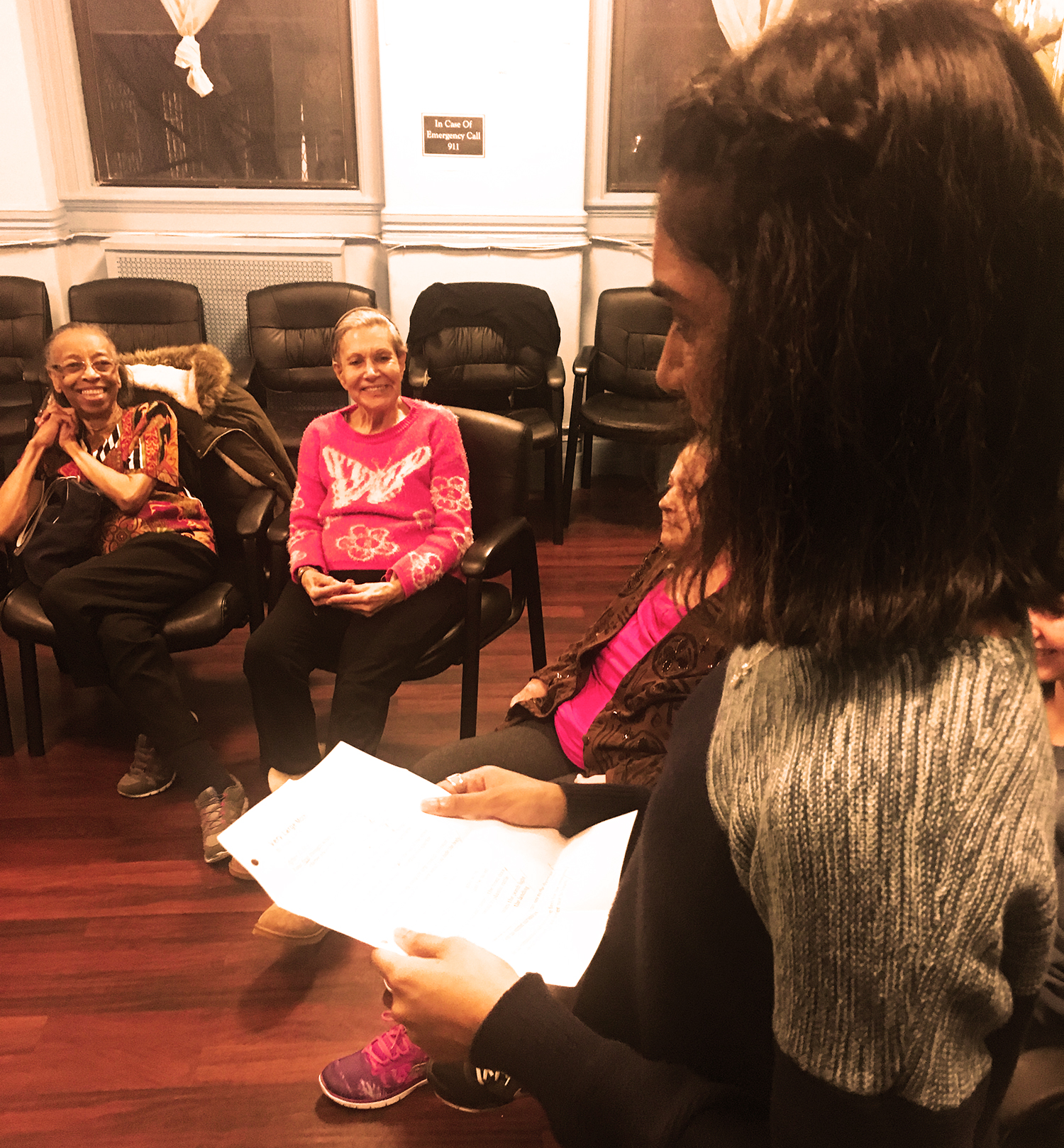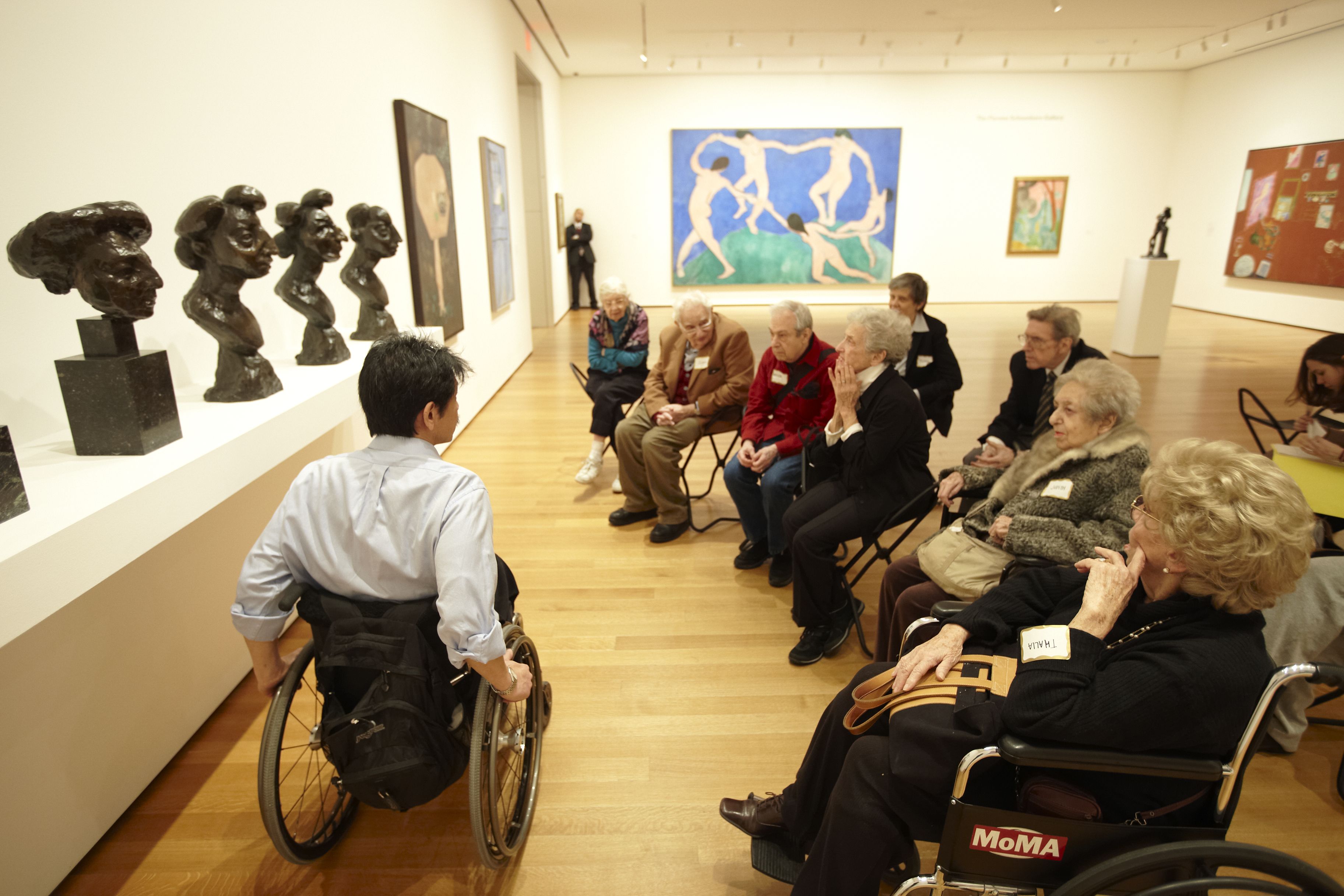Abstract
A diagnosis of dementia profoundly impacts a person in terms of both the functional progression of the disease and the social stigma associated with the diagnosis. A growing body of research demonstrates the effectiveness of innovative programs such as the Alzheimer’s Poetry Project, Meet Me at MoMA, and TimeSlipsTM in counterbalancing social stigma by building a social and emotional framework for strength-based living for people diagnosed with dementia through arts participation. These programs focus on supporting autonomy and generativity through creative expression to help sustain the social, emotional, and community fabric of people’s lives in the face of significant counterbalancing forces (e.g., the disease itself, stigma, and institution-centered approaches to care).
Introduction
The poem springs from the half-spoken words of such patients as the physician sees from day to day…. This, in the end, comes perhaps to be the occupation of the physician after a lifetime of careful listening.
William Carlos Williams [1]
A diagnosis of dementia profoundly impacts a person in terms of both the functional progression of the disease and the social stigma associated with the diagnosis. People become more isolated as the stigma intensifies and often lose any kind of social and emotional framework for strength-based living that focuses on attributes such as hope and capacity for loving relationships [2, 3]. There is a growing body of research demonstrating the effectiveness of arts participation in both breaking down isolation and reducing social stigma associated with the diagnosis of dementia [4-6]. William Carlos Williams, in the quotation above and in a previous passage explains:
We begin to see that the underlying meaning of all they want to tell us and have always failed to communicate is the poem, the poem which their lives are being lived to realize…. It is actually there, in the life before us, every minute that we are listening…. It is that essence which is hidden in the very words which are going in at our ears and from which we must recover underlying meaning as realistically as we recover metal out of ore [7].
Innovative arts programs such as the Alzheimer’s Poetry Project, Meet Me at MoMA (Museum of Modern Art), and TimeSlipsTM have been designed to engage people with memory loss and their caregivers and to recover their lives’ underlying meaning through person-centered care. Now being replicated across the country, these evidence-based programs demonstrate that arts participation can connect or reconnect persons with dementia by improving communications, increasing social engagement, and reducing agitation. For example, Philips, Reid-Arndt, and Pak [8] demonstrated that a TimeSlips storytelling intervention increased pleasure and improved communication skills for people with dementia at one-week post-intervention. Other studies have demonstrated the effectiveness of TimeSlips interventions in substantially improving caregiver attitudes towards people with dementia, including those of medical students [9, 10]. Similarly, a study of Meet Me at MoMA interventions found statistically significant and substantial visible mood changes in both the caregiver group and the people with dementia [11]. Moreover, in the same study, people with dementia reported enhanced self-esteem, and caregivers appreciated seeing their family members treated with respect and being able to engage with them in a gracious and beautiful environment [11].
Let us take a closer look at these three evidenced-based programs and examine what makes them successful.
Three Innovative Arts Programs Designed to Engage People with Dementia and Their Caregivers
The Alzheimer’s Poetry Project [12], founded by the poet Gary Glazner, trains caregivers worldwide to use poetry as a tool to spark imagination. The project includes special programs, such as memory cafés, which are a series of free arts events for people living with Alzheimer’s disease or dementia, their caregivers, family members, and the general public [13]. Glazner also founded Poetry for Life [14], an intergenerational program that builds on the successful Poetry Out Loud school-based poetry recitation competition run by the National Endowment for the Arts [15]. Poetry for Life brings together high school students and people living with Alzheimer’s or dementia to enjoy reciting poetry together [14], an activity that reinforces each other’s value (see figure 1).
Figure 1. Poetry for Life with Brooklyn Technical High School Students at New York Memory Center

Photo: Gary Glazner
Meet Me at MoMA is a museum-based program of the MoMA Alzheimer’s Project within the Museum of Modern Art (MoMA) in New York City [16]. Developed by MoMA’s education department, this innovative program takes advantage of the museum’s quiet times to bring together trained museum educators and people with dementia and their caregivers to explore great works of art, such as Vincent van Gogh’s Starry Night, from their collection. Participants engage with their imaginations in a limitless world, interpreting what the art means to them in that moment. Observers might not be able to distinguish between the caregivers and their care partners, as all are engaged in meaningful conversations about each piece of artwork presented (see figure 2). MoMA also developed evidence-based training modules to disseminate this model to museums across the country [17].
Figure 2. Photograph of the Meet Me at MoMA Program

Copyright © 2017 The Museum of Modern Art, New York. Photo: Jason Brownrigg
TimeSlips, founded by MacArthur Fellow Anne Basting, is a creative project that engages groups of people with dementia through storytelling [18]. Online training information enables caregivers to support meaningful exchanges. Each group session is led by a TimeSlips facilitator, who leads the group as it explores a large photograph featuring images intended to encourage storytelling, such as a black and white photo of a baby in a leather handbag, a photo of a person holding a large frog, or a photo of people playing in the rain. As the participants comment on their observations about the photo, a second person documents the remarks and, together with the facilitator, they create a story about the photo. Imagination rules and memories are sparked. No comments made by the participants are excluded. Caregivers and care partners laugh and enjoy the moments of interaction, each beyond the grasp of the progressing disease. Stories can then be submitted to the TimeSlips website, which is building an online community of people with dementia and their caregivers [19]. TimeSlips has made a profound change in person-centered care for people with dementia, expressing respect for their dignity by including their contributions and stories and offering opportunities for them to share their life experiences in ways that honor and accept their present selves without comparison to their prior selves.
What Makes These Programs Successful?
What are the elements of these and other similar arts programs that make them successful and how can facilitators implement them? Although each program engages different arts forms, all have common elements in how they engage people with dementia. Here are several key elements:
- Introductions. Every session leader should start by taking time to welcome participants. Saying “hello” to each person and making eye contact are important ways to start the group activity. Introducing both yourself and the activity gives the program a respectful and clear start.
- Program participation. Set high expectations for engagement and be prepared to improvise the plan for the activity in order to reach each participant. Accept all contributions and integrate participants’ experiences into a whole using the “yes, and” approach, which accepts each person’s response (“yes”) and adds it to the story being created or told (“and”), rather than offering a negative or corrective response.
- Program content. Commit to presenting high-quality arts experiences that are age-appropriate. Although people with dementia lose their cognitive abilities as this disease progresses, activities should be maintained that engage older adult learners by treating their life experience with respect. In our experience, the power of creative expression is that it lifts people with dementia out of isolation.
- Environment. Secure space conducive to engagement. Keep visual and auditory distractions to a minimum so that participants can easily see the facilitator and the art form presented, and so they can hear instructions and others’ responses in the room.
- Closure. Every program should end with a celebration of what was accomplished together, such as the sharing of a group poem or story or key discussion points about a piece of visual art. Thanking and saying “goodbye” to each participant, with eye contact and appropriate physical touch, is important.
An Example from a TimeSlips Session
To anchor these concepts, consider this example of storytelling witnessed by one of the authors (GH). It focuses on an art program participant in a TimeSlips activity at a skilled nursing long-term care facility. Let’s call her Carla.
When the nursing assistant rolled Carla into the already-gathered circle of long-term care participants, there were groans and sighs of frustration heard all around. Carla tended to respond to every situation by uncontrollably laughing at everyone and everything, frustrating the other residents. The TimeSlips facilitator introduced herself and then greeted everyone, making eye contact with each participant, including Carla. The facilitator started the program by bringing out a large photograph of a polar bear with eyeglasses looking towards an open newspaper sprawled out on a sheet of ice surrounded by snow (see figure 3), while the recorder wrote down comments from the participants. The facilitator asked the participants what they thought the bear was doing and why he was there. The answers, comments, and laughter started to whirl around as the participants became engaged in the discussion and the story developed: “He has been dancing and fell down,” “His wife just left him and he is sad.” All the while, Carla continued to laugh. The facilitator included Carla’s laughter in the story as it evolved, saying “and Carla laughed.” Soon Carla’s laughing quieted as she too became engaged in developing the story with comments instead of laughter. The other participants in the group began to respond to her with respect instead of frustration. By the end of the hour, everyone was fully engaged in imagining a story around this big white bear. The participants seemed to enjoy the process, and the storytelling gave the community assembled on the ward a feeling of belonging and contributing. Carla later told the session recorder that she laughs at things she can’t control. The creative process, engagement with others, and guidance from the facilitator provided Carla with a measure of control, respite, and a feeling of inclusion. It offered her a meaningful experience that reduced the stigma of her specific condition among her fellow residents.
Figure 3. Polar Bear Father's Day Greeting Card

Copyright © Avantipress.com
Transferring Group Facilitator Skills to Clinical Practice
How can the lessons learned from the TimeSlips group contribute to your clinical practice in caring for people with dementia? First and foremost, respect and accept each person with dementia in the moment of his or her experience with the activity. Try to give positive responses and move the interaction forward, while listening and responding with not only high expectations for participation but also imagination and humor. Verbal critical judgments and corrections have no place in interactions with persons who have dementia. It is crucial that you recognize that the person is still there with you even though the memories and abilities to communicate are fading. Listening and improvising is an important art form in caring for people with dementia. Clinicians might find it helpful to consult the National Center for Creative Aging’s online “Creative Caregiving Guide,” which features the three aforementioned innovative programs as well as several other programs that utilize music, visual arts, and dance [20].
In conclusion, arts participation in well-designed, person-centered programs that encourage imagination and creativity to be expressed freely can bring joy and counterbalance the stigma of the diagnosis and the progression of the disease [21]. A newly diagnosed Alzheimer’s patient said after participating in the TimeSlips program, “The revelation that I can’t remember but I CAN imagine blessed my mind, heart, and soul” [19], which illustrates the power of imagination and creativity to bring comfort and break down isolation and to cultivate opportunities for self-expression with dignity and respect. Can these benefits of high-quality interaction be achieved throughout the continuum of caregiving? William Carlos Williams seemed to think so.
References
-
Williams WC. The Autobiography of William Carlos Williams. New York, NY: New Directions; 1967:362.
-
Cohen D. The Mature Mind: The Positive Power of the Aging Brain. New York, NY: Basic Books; 2005.
- Isaacowitz D, Vaillant G, Seligman ME. Strengths and satisfaction across the adult lifespan. Int J Aging Hum Dev. 2003;57(2):282-204.
-
Vella-Burrows T. The arts and older people: a global perspective.
Google Scholar
In: Clift S, Camic PM, eds. Oxford Textbook of Creative Arts, Health, and Wellbeing: International Perspectives on Practice, Policy, and Research. New York, NY: Oxford University Press; 2016:235-244. - Fraser A, Bungay H, Munn-Giddings C. The value of the use of participatory arts activities in residential care settings to enhance the well-being and quality of life of older people: a rapid review of the literature. Arts Health. 2014;6(3):266-278.
- George DR, Stuckey HL, Whitehead MM. An arts-based intervention at a nursing home to improve medical students’ attitudes toward persons with dementia. Acad Med. 2013;88(6):837-842.
-
Williams, 361-362.
- Philips LJ, Reid-Arndt SA, Pak Y. Effects of creative expression intervention on emotions, communication, and quality of life in persons with dementia. Nurs Res. 59(6):417-425.
- Fritsch T, Kwah J, Grant S, Lang J, Montgomery RR, Basting AD. Impact of TimeSlips, a creative expression intervention program, on nursing home residents with dementia and their caregivers. Gerontologist. 2009;49(1):117-127.
- George DR, Houser WS. “I’m a storyteller!”: exploring the benefits of TimeSlips creative expression program at a nursing home. Am J Alzheimers Dis Other Demen. 2014;29(8):678-684.
-
Mittelman M, Epstein C. The NYU evaluation of Meet Me at MoMA. In: Rosenberg F, Parsa A, Humble L, McGee C, eds. Meet Me: Making Art Accessible for People with Dementia. New York, NY: Museum of Modern Art; 2009:87-105.
https://www.moma.org/momaorg/shared/pdfs/docs/meetme/Print_
1_Research.pdf. Accessed May 8, 2017. -
Alzheimer’s Poetry Project website. http://www.alzpoetry.com. Accessed February 6, 2017.
-
Alzheimer’s Poetry Project. Memory arts café. http://www.alzpoetry.com/memory-arts-cafe/. Accessed February 28, 2017.
-
Alzheimer’s Poetry Project. Poetry for life. http://www.alzpoetry.com/poetry-for-life-1/. Accessed February 6, 2017.
-
Poetry Out Loud website. http://www.poetryoutloud.org/. Accessed February 6, 2017.
-
Museum of Modern Art. Meet Me: the MoMA Alzheimer’s Project. https://www.moma.org/meetme/index. Accessed February 6, 2017.
-
Museum of Modern Art. Meet Me: the MoMA Alzheimer’s Project: lessons for engagement with art. https://www.moma.org/meetme/modules/index. Accessed May 8, 2017.
-
TimeSlipsTM website. http://www.timeslips.org. Accessed February 6, 2017.
-
TimeSlipsTM. Testimonials. http://www.timeslips.org/train/testimonials. Accessed February 6, 2017.
-
National Center for Creative Aging website. http://www.creativeaging.org. Accessed March 20, 2017.
-
Lambert P, ed. Managing Arts Programs in Healthcare. London, UK: Routledge; 2016.



